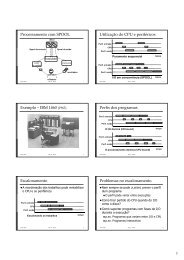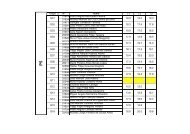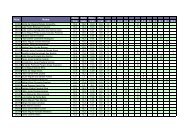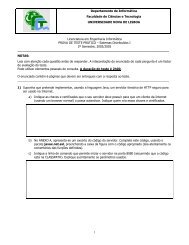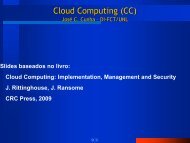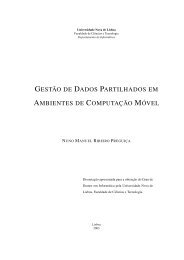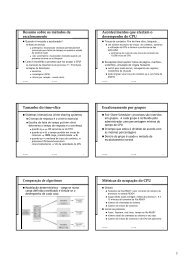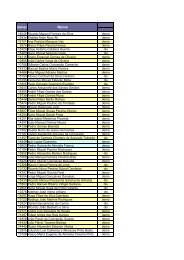Dissertaç ˜ao de Mestrado Mestrado em Engenharia Informática Jo ...
Dissertaç ˜ao de Mestrado Mestrado em Engenharia Informática Jo ...
Dissertaç ˜ao de Mestrado Mestrado em Engenharia Informática Jo ...
Create successful ePaper yourself
Turn your PDF publications into a flip-book with our unique Google optimized e-Paper software.
6. INTEGRATION WITH VIRTU 6.4. SmART integration<br />
Processing Layer, the Web Front-End uses the External Interfaces component as<br />
an interface to the tool.<br />
6.3.4 Other Notable Sectors<br />
Apart from the presented layers and components, VIRTU makes use of other sectors that are not<br />
inclu<strong>de</strong>d in the tool architecture, but their relevance is consi<strong>de</strong>rable enough for the integration<br />
of SmART with VIRTU.<br />
The VIRTU tool <strong>em</strong>ploys some third-party software which is also integrated with the tool,<br />
as is the case of MySQL for the provision of a relational database manag<strong>em</strong>ent syst<strong>em</strong> or Eclipse<br />
for the linkage of Java objects to the database. These components are COTS (Commercial, off-<br />
the-shelf), software built by other entities which can be integrated with the objective of quickly<br />
providing functionalities to the tool, possibly saving time by r<strong>em</strong>oving the need to build those<br />
functionalities from scratch, but at the cost of some integration work. VIRTU keeps these third-<br />
party components in a CVS (Concurrent Versions Syst<strong>em</strong>) repository, from where they can be<br />
accessed.<br />
Another important data sector is located insi<strong>de</strong> the virtual machines created by the tool.<br />
This sector hosts the first-run and configuration scripts which are ran automatically by each<br />
virtual machine so that they get the required data from the tool autonomously.<br />
6.4 SmART integration<br />
The VIRTU workflow and architecture were <strong>de</strong>scribed in the previous sections. Using that<br />
knowledge, this section <strong>de</strong>scribes how SmART fits in the VIRTU workflow and the where-<br />
abouts of the SmART component plac<strong>em</strong>ent in the VIRTU architecture. The integration takes<br />
on both SmART major components, the Original to Generic syntax Converter (OGC) and the<br />
Generic to Original syntax Converter (GOC, see Section 3.2), and <strong>em</strong>ploys th<strong>em</strong> on separate<br />
VIRTU components. OGC is used in the creation of configuration file t<strong>em</strong>plates when adding<br />
new Building Blocks to VIRTU while GOC is used by the virtual machines to generate config-<br />
uration files from t<strong>em</strong>plates.<br />
In the VIRTU workflow, SmART will be called for the first time when an administrator adds<br />
new Building Blocks. As it was seen in Section 6.3.1, these can either be applications, oper-<br />
ating syst<strong>em</strong>s or virtual machines. In this case, a Publication File needs to be associated<br />
to that Building Block. For this en<strong>de</strong>avour, SmART is used to transpose the Building<br />
Block configuration files, whose parameterization is relevant, into XML documents, generat-<br />
ing a Publication File. This Publication File is then stored in the Configuration<br />
Database, from where it is obtained when its usage is required (i.e., when a user requires<br />
the instantiation of an Ass<strong>em</strong>bly Configuration composed by that Building Block).<br />
There might be the case where one or more configuration files of an application are unknown<br />
to the tool. If such is the occasion, the administrator must <strong>de</strong>fine a grammar which recognizes<br />
the new configuration file in or<strong>de</strong>r to build a parser for it. In the end, a new Building<br />
74



